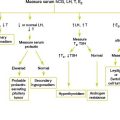Chapter 35 PRECOCIOUS PUBERTY
Causes of Precocious Puberty (Adapted from Tables 1 and 2 in Fahmy)
GnRH-Dependent Precocious Puberty
GnRH-Independent Precocious Puberty
Key Physical Findings
 Head and neck examination to evaluate the optic fundi, estimate the visual fields, and evaluate the sense of smell
Head and neck examination to evaluate the optic fundi, estimate the visual fields, and evaluate the sense of smell
 Determination of the Tanner stage of pubertal development
Determination of the Tanner stage of pubertal development
 Breast examination for pubertal development and asymmetry
Breast examination for pubertal development and asymmetry
 Genital examination for pubertal development and testicular abnormalities
Genital examination for pubertal development and testicular abnormalities
Suggested Work-up
| Radiograph of the left wrist | To estimate physiologic age for comparison with the child’s chronologic age |
| Serum follicle-stimulating hormone (FSH) and luteinizing hormone (LH), estradiol, testosterone, thyroid-stimulating hormone (TSH), thyroxine (T4), and human chorionic gonadotropin (hCG) | To confirm the impression of idiopathic precocious puberty, to localize the abnormality of the pathologic cause of precocious puberty, or to guide the choice of imaging study |
| Serum 17-hydroxyprogesterone and dehydroepiandrosterone (DHEA) | If a peripheral cause is suspected or if virilization is present in a female patient |
| Pelvic ultrasound | Used to determine whether pubertal changes have occurred in the uterus and ovaries. Also indicated if a peripheral cause (ovarian tumor) is suspected. |
Additional Work-up
| Magnetic resonance imaging (MRI) of the brain and pituitary gland | If a central pathologic cause is suspected on the basis of hormone measurements. Also indicated in boys with elevated hCG levels. |
| GnRH stimulation test | 100 µg of GnRH is administered either intravenously or subcutaneously after an overnight fast. Serum levels of FSH and LH are measured at baseline just before the injection and at 15, 30, 45, and 60 minutes after the injection. Test interpretation is controversial, but a twofold to threefold rise in FSH and LH may be observed if the patient has central precocious puberty. A peak LH level of more than 15 international units per liter or a peak LH-to-peak FSH ratio of more than 0.66 are also criteria for defining a pubertal GnRH test. |
| Breast ultrasound | Indicated in unilateral or asymmetric premature thelarche to exclude masses |
| Testicular ultrasound | Indicated if asymmetric enlargement of the testes is present |
| Skeletal survey or radionuclidebone scan | Indicated for patients with McCune-Albright syndrome to evaluate for lesions of fibrous dysplasia |
1. Bates G.W. Hirsutism and androgen excess in childhood and adolescence. Pediatr Clin North Am. 1981;28:513–530.
2. Blondell R.D., Foster M.B., Dave K.C. Disorders of puberty. Am Fam Physician. 1999;60:209–224.
3. Fahmy J.L., Kaminsky C.K., Kaufman F., Nelson M.D., Parisi M.T. The radiological approach to precocious puberty. Br J Radiol. 2000;73:560–567.
4. Klein K.O. Precocious puberty: who has it? who should be treated? J Clin Endocrinol Metab. 1999;84:411–414.





























